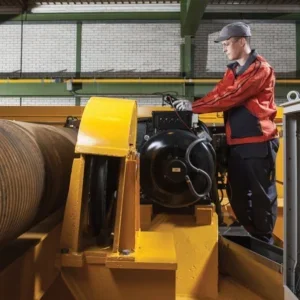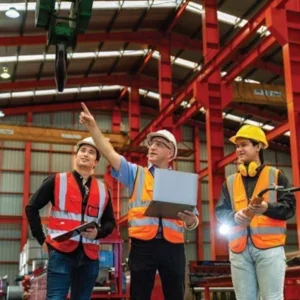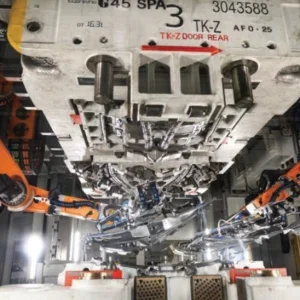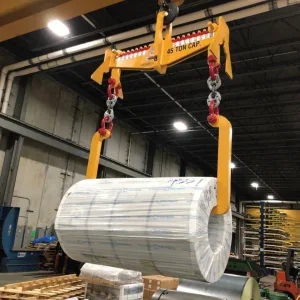More particularly, it relates to a buffer crane having radiation emission scanning apparatus arranged for nonintrusive interrogation or inspection of cargo containers while each container is being transferred between a ship and quay side land transportation without slowing the quay crane container transfer cycle.
It suspends the cargo container being transferred at a predetermined inspection position for radiation emission examination by a craneboard apparatus before depositing the cargo container at the intended transfer buffer deposition position.
The container is then either deposited on land transportation such as a truck trailer chassis or deposited on the buffer position for pickup by a quay crane for transfer to a ship.
The platform has at least a first predetermined container buffer deposition position located thereon for a cargo container where it can be located for pickup or deposition by a quay crane.
Background
In view of recent terrorist activities throughout the world, considerable effort is being given by analysts to improving security measures with respect to the maritime industry and United States port operations.
At the present time, based on the Automated Tracking System, an intelligence based search system used by US Customs, it has been estimated that the probability that contraband will be discovered in containers that are entering the US is less than 50%.
Thus, the maritime industry provides a delivery system for weapons of mass destruction and every other container could possibly conceal an atomic weapon which, if exploded in a US port, in addition to causing massive destruction, would essentially end international trade.

Figure 1 (top) is a side elevational view of a typical quay crane with a mobile cargo container scanning crane according to the present invention located thereunder.
Figure 2 is an upper perspective view of the scanning crane of the present invention shown in operation.
The methods to be employed to improve US port security may prove severely detrimental to port productivity. The ideal performance standard is 100% inspection of inbound containers to US ports. Rather than physically unloading and inspecting the contents of every container, a more efficient alternative is to nonintrusively inspect each container such as by x-ray, and when more sophisticated means of nonintrusive inspection are developed, such as gamma ray scanning and neutron analysis, implementing the use of those developments in addition to x-ray based systems.
Technical illustrations
Figure 1 shows a typical container handling quay crane (11) located dockside in a shipping port. It is mounted on rails disposed parallel to the dock edge (13). The quay crane traverses the wharf to position itself to project its cantilevered boom (15) over the rows of container cells of the adjacently berthed ship (17) when the boom is lowered.
The scanning bridge crane (19) of the present invention is shown disposed below the quay crane between the support legs (21). It comprises a rigid framework having four or more legs mounted on pneumatic tyres (23) for independent movement on the wharf such that it can be located at variable positions below or adjacent to the quay crane either between the support legs or alongside under a cantilevered shoreside back reach (25).
The scanning crane (19) is a low-profile buffer crane having a maximum height permitting it to be positioned underneath a quay crane (11) between its support legs (21) during container handling operations. It is contemplated that a buffer/scanning crane could also be utilised in a railroad stacking yard, under a large bridge or straddle crane, as well as dockside, so the term ‘quay crane’ as used in the claims to describe the environment of the invention is intended to include these and other types of container storage yard and railyard container handling cranes as well.
Reference is made to Figures 2-4 which disclose a mobile cargo container buffer/scanning bridge crane (19) in operation as contemplated by the present invention. The crane is comprised of a multiple tyre (23) or a wheel-supported platform (27) having a floor and formed for independent movement in a quay area. It is essentially a landing deck mounted on legs so that container transporters can pass underneath.
The landing deck can thereby function as a buffer crane quite effectively and even more so when constructed with multiple landing positions for containers as described in the patents described supra and incorporated herein.
The landing deck or platform (27) has a first predetermined position (29, see Figure 3) for the deposit of containers (31) which have been offloaded from a ship by a quay crane or where containers being transferred from land transportation can be landed until picked up by the quay crane for transfer to a ship.
This first predetermined position is labeled the ‘first’ for designation purposes and does not necessarily describe its position as a sequence step in container transfer operations except in the one specific mode of crane operation: ship to shore transfer.
Conversely, it is the last predetermined position in a shore to ship container transfer. Therefore, the designation as a first position is an arbitrary selection simply because the most immediate need in the industry is for inspection of containers being landed in the United States, and that sequence starts with the quay crane landing the container first on the buffer deposition position of the scanning crane.
This first predetermined position (29) can actually be comprised of a number of landing positions for the temporary storage of containers during ship loading and unloading operations whereby the scanning crane (19) can also function as a buffer crane as taught by related and incorporated patents, although a single buffer deposition position can be sufficient under some conditions for the scanning crane to function adequately as a buffer crane.
The scanning buffer crane (19) has a second predetermined position (33) which, in the illustrated embodiment of the invention, is a suspended position where a container is held for nonintrusive examination. It can also be a landing position depending upon the type of scanning apparatus which is employed.

Figure 3 is an end view of the scanning crane shown in Figure 2.
Figure 4 is a side elevational view of the scanning crane shown in Figure 2.
The scanning crane (19) can remain engaged to or hold onto a container being transferred between ship and shore for a reasonably long period of time during the transfer operations in relation to the cycle time of the quay crane (11) in order to inspect a container.
A bridge crane (35) is mounted on a pair of leg-supported crossbeams (37) above the mobile platform and generally spans the length of the cargo containers it is intended to handle.
In that case, it would be necessary to lift or deposit containers from and to transporters parked alongside the scanning crane. To do so, the support rails for the bridge crane on the crossbeams (37) would be extended to project laterally over the adjacent truck parking positions with cantilevered beam projections.
A container scanning inspection or interrogation apparatus (39) is mounted on the platform (27) and is formed for reciprocating longitudinal movement on a trolley (41) above the platform (27) to traverse the length of a cargo container (43) suspended by the bridge crane (35) at the second predetermined position (33).
It is mounted on a wheeled trolley which runs on rails (45) that extend for substantially the length of the platform. The second predetermined position could be a deposition position on the front of the scanning apparatus support platform.
The scanning apparatus (39) can be provided with a hold or rest position at one end of the platform as shown in Figure 4.
As presently envisioned, due to the physical construction and space requirements of presently available and utilised scanning apparatus, the reciprocating and translating trolley (41) is mounted on a first set of dual parallel tracks (45) so it can slide horizontally from one end of a container (43), suspended at the second predetermined position (33), to the other.
In all likelihood, the scanning apparatus (39) will have to be able to traverse the length of a container, but it is possible that with improved scanning techniques, it will only need to move to one or more fixed positions along the length of the container.
In such a case, the second predetermined position could be a buffer deposition position on the front of the scanning apparatus trolley platform (41). Nevertheless, with reference to Figures 2-4, it can be seen that when the scanning apparatus (39) is in the rest position, as shown in Figure 4 the first set of tracks (45) are sufficiently spaced apart such that a cargo container (43) can be raised and lowered between tracks (45) to and from the second predetermined position (33), shown in Figures 2 and 3, and land transportation vehicles at ground level below tracks (45).
With reference to Figure 3, the scanning apparatus (39) envisioned by the present invention includes a focused radiation emitter (47) housed in a shield (49) which directs radiation R, shown in dotted lines, toward the container (43) suspended at the second predetermined position (33).
A receptive screen and radiation shield (51) are positioned behind the container and supported by the same reciprocating platform or trolley (41) which supports the radiation emitter and its shielding. The scanning apparatus support and trolley platform (41) also functions as a shield to prevent radiation from scattering downward in order to protect dockside workers and truck driver personnel located under the platform (27).
A shield door (53) mounted on rollers can be provided under the scanning apparatus to cover the access door in the floor of the landing deck during scanning to prevent radiation from reaching the truck drivers and dock personnel. In the illustrated embodiment, shield door (53) is supported on a second set of dual, spaced-apart tracks (55) disposed perpendicularly to and below the first set of tracks (45).
Shield door (53) can thence be rolled from a first position directly below a cargo container (43) being held suspended in the second predetermined position (33), as seen in Figures 2 and 3, to a second position horizontally removed from the second predetermined position (33).
Thus, when the shield door (53) is moved away from the first position the cargo container (43) can be moved vertically between the second set of tracks (55) to and from the second predetermined position (33) and land transportation vehicles at ground level.
When a cargo container is transferred by the bridge crane from either the land-side transportation (third predetermined position) or the quay crane landing position (first predetermined position, 29) to the intended receiving deposition position, it is stopped during transit at the second predetermined position (33), and the nonintrusive scanning apparatus (39) moves along the length of the landing platform (27) to scan the suspended container (43) at the second predetermined position before it is lowered onto the land transportation truck trailer chassis or moved to land on one of the buffer crane landing positions (the first predetermined position, 29).
The presently available scanning apparatus (39) can include x-ray machines and gamma ray detectors, and eventually neutron analysis machines.
About the patent
Toru Takehara, Kinya Ichimura, Sun Huan Huang and Philip Alexander Tam (all of California) were awarded US Patent 7,677,857 on March 16, 2010 (the assignee was Paceco Corp). Patent application number 10/639,957 was filed on August 12, 2003.
Disclaimer
As edited versions of the originals, this article and accompanying drawings may omit legally or technically important detail.






